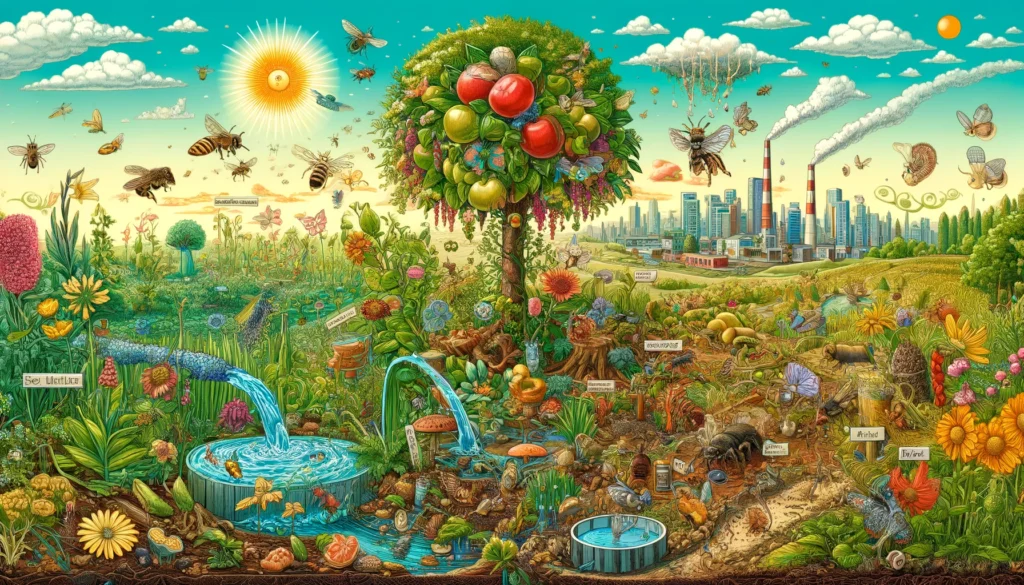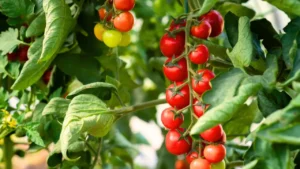
Biodiversity Conservation A vivid and detailed illustration showing ecosystem services. Depict pollination water purification and soil fertility in a diverse healthy ecosyst1.webp.webp
Definition: Biodiversity Conservation
Biodiversity Conservation refers to the practice of protecting and managing the diversity of species, ecosystems, and genetic resources to ensure their sustainability and resilience. This involves measures to preserve natural habitats, protect endangered species, and maintain ecological processes.
Why is Biodiversity Conservation Important?
Biodiversity conservation is crucial for maintaining the balance of ecosystems and ensuring the sustainability of life on Earth. It involves protecting the variety of life forms, their genetic differences, and the ecosystems they form. Here, we explore the importance of biodiversity conservation, its principles, benefits, strategies for implementation, and its impact on farming and global ecosystems.
Fall off the barn roof and busted your keister? Life on the farm or ranch can be tough on the bum. Need a break? Laugh it off at FarmerCowboy.com, the #1 farm humor site. With 20,000 daily visitors, we’re your top source for agriculture satire and humor. Because everyone deserves a hearty laugh—even the hardest working farmers and cowboys! Join us and turn those long days into fun tales at FarmerCowboy.com.
Principles of Biodiversity Conservation
- Ecosystem Approach: Conserving entire ecosystems to maintain their functions and processes ensures that species can thrive in their natural environments.
- Species Conservation: Protecting endangered and threatened species through legislation, protected areas, and breeding programs.
- Genetic Diversity: Preserving the genetic variation within species is essential for adaptability and resilience to environmental changes.
- Sustainable Use: Emphasizing the sustainable use of natural resources to meet human needs without compromising the health of ecosystems.
- Community Involvement: Engaging local communities in conservation efforts ensures the sustainability and success of biodiversity projects.
Importance of Biodiversity Conservation
Environmental Importance
- Ecosystem Services: Biodiversity underpins essential ecosystem services, such as pollination, nutrient cycling, water purification, and climate regulation. These services are vital for the survival of all life forms, including humans.
- Resilience: Diverse ecosystems are more resilient to environmental changes and disturbances, such as climate change and natural disasters. This resilience is critical for the stability of the planet’s life-support systems.
- Interconnectedness: Species depend on each other for survival. The loss of one species can have cascading effects on others, disrupting ecosystem balance and function.
Economic Importance
- Agriculture: Biodiversity contributes to agriculture through pollination, pest control, and soil fertility. Crop diversity ensures food security and resilience against pests and diseases. For example, diverse crop rotations can improve soil health and reduce the need for chemical inputs.
- Medicine: Many medicines are derived from natural products. Biodiversity conservation ensures the availability of genetic resources for pharmaceutical development. For instance, compounds from rainforest plants have been used to treat diseases like cancer and malaria.
- Tourism: Biodiversity-rich areas attract tourism, which can be a significant source of income for local communities. Eco-tourism promotes conservation while providing economic benefits.
Social Importance
- Cultural Values: Biodiversity is integral to many cultures, providing inspiration, spiritual value, and a sense of place. Indigenous communities, in particular, have deep cultural ties to their natural environments.
- Livelihoods: Many communities depend directly on biodiversity for their livelihoods, including fishing, agriculture, and forestry. Sustainable use of biodiversity ensures these communities can thrive.
- Health and Well-being: Access to diverse natural environments contributes to human health and well-being. Nature exposure is linked to reduced stress and improved mental health.
Strategies for Biodiversity Conservation
Protected Areas
Establishing protected areas, such as national parks, wildlife reserves, and marine sanctuaries, is a key strategy for biodiversity conservation. These areas safeguard habitats and species from human activities and provide a refuge for endangered species.
Sustainable Land Use
Implementing sustainable land-use practices, such as agroforestry, organic farming, and sustainable forestry, helps maintain biodiversity while meeting human needs. These practices minimize habitat destruction and promote ecosystem health.
Restoration Ecology
Restoration ecology involves rehabilitating degraded ecosystems to restore their functions and biodiversity. Activities include reforestation, wetland restoration, and invasive species management.
Conservation Legislation
Enacting and enforcing laws that protect endangered species and their habitats is essential for biodiversity conservation. International agreements, such as the Convention on Biological Diversity (CBD), provide a framework for global cooperation.
Community-Based Conservation
Involving local communities in conservation efforts ensures that they benefit from and support biodiversity conservation. Community-based approaches leverage traditional knowledge and encourage sustainable resource use.
Practical Applications of Biodiversity Conservation
Habitat Protection
Protecting and managing habitats is fundamental to biodiversity conservation. This includes creating and maintaining protected areas, restoring degraded habitats, and managing human activities that impact ecosystems.
Species Management
Efforts to protect specific species include breeding programs, habitat restoration, and legislation to prevent poaching and illegal trade. For example, the recovery of the American bald eagle is a success story of species management.
Sustainable Agriculture
Sustainable agricultural practices, such as crop rotation, agroforestry, and organic farming, help conserve biodiversity by maintaining habitat diversity and reducing chemical use. These practices support pollinators and natural pest control.
Climate Change Mitigation
Biodiversity conservation is integral to climate change mitigation. Forests and wetlands, for instance, sequester carbon, helping to regulate the climate. Protecting these ecosystems is crucial for mitigating global warming.
Public Awareness and Education
Raising awareness and educating the public about the importance of biodiversity is essential for fostering a conservation ethic. Outreach programs, educational materials, and community involvement can drive conservation efforts.
How Biodiversity Conservation Helps Farmers
- Enhanced Ecosystem Services: Biodiversity supports vital ecosystem services, such as pollination, pest control, and nutrient cycling, which are essential for productive agriculture.
- Soil Health: Diverse plant and animal species contribute to healthy soils by enhancing organic matter, promoting beneficial soil organisms, and preventing erosion.
- Pest and Disease Control: Natural predators and diverse cropping systems reduce the reliance on chemical pesticides, leading to healthier crops and reduced costs.
- Resilience to Climate Change: Biodiversity-rich agricultural systems are more resilient to climate variability and extreme weather events, ensuring stable food production.
- Access to Genetic Resources: Biodiversity provides a reservoir of genetic material for crop and livestock improvement, helping farmers develop resilient and productive varieties.
Conclusion
Biodiversity conservation is a cornerstone of sustainable development. It ensures the health and resilience of ecosystems, supports human well-being, and provides economic opportunities. By adopting conservation practices, protecting habitats, and engaging communities, we can safeguard biodiversity for future generations. Farmers, in particular, stand to benefit significantly from biodiversity conservation through enhanced ecosystem services, improved soil health, and increased resilience to environmental changes.

How Biodiversity Conservation Can Help Farmers
Biodiversity conservation helps farmers by enhancing ecosystem services, improving soil health, providing natural pest and disease control, increasing resilience to climate change, and ensuring access to valuable genetic resources. These benefits contribute to sustainable and profitable farming systems while supporting environmental conservation and social well-being.

Originally posted 2024-05-28 10:42:26.
Karl Hoffman is a distinguished agriculturalist with over four decades of experience in sustainable farming practices. He holds a Ph.D. in Agronomy from Cornell University and has made significant contributions as a professor at Iowa State University. Hoffman’s groundbreaking research on integrated pest management and soil health has revolutionized modern agriculture. As a respected farm journalist, his column “Field Notes with Karl Hoffman” and his blog “The Modern Farmer” provide insightful, practical advice to a global audience. Hoffman’s work with the USDA and the United Nations FAO has enhanced food security worldwide. His awards include the USDA’s Distinguished Service Award and the World Food Prize, reflecting his profound impact on agriculture and sustainability.






